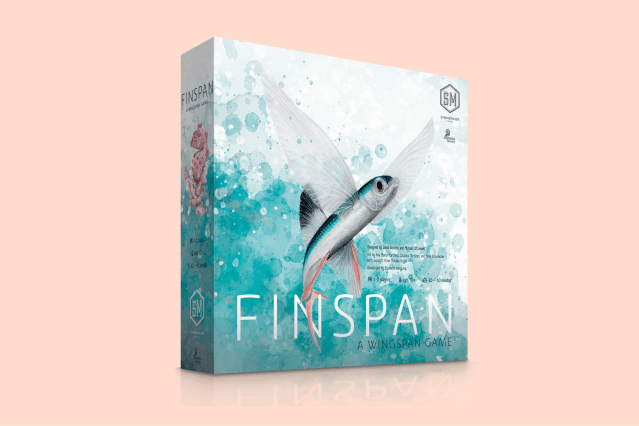
Finspan
Finspan is the aquatic-themed successor to 2019’s avian-themed Wingspan and 2024’s dragon-themed Wyrmspan. Right off the bat, it’s hard not to be struck by the game’s vibrant and colorful design. There are more than 100 cards drawn by a series of talented artists, each featuring a detailed illustration of one of the game’s variety of marine creatures.
Each player board itself is equally beautiful, featuring three sections for three different parts of the ocean, known as the sunlight, twilight, and midnight zones. While the aesthetics of the game are reason enough to play, the gameplay itself is also fun and easy to pick up.
Between one and five people can play, each of whom takes on the role of a marine researcher. The goal is to amass the most victory points, which can be achieved by playing species cards with varying point totals printed on them, placing egg and fish tokens on the board, and hatching schools of fish.
Developer Stonemaier Games acknowledges that Finspan is designed to be slightly less complex than Wingspan, which makes it easier to learn and results in a game that’s far more forgiving of mistakes. Each playthrough is estimated to take 45 to 60 minutes, giving you and your friends or family ample time to get a couple rounds in before calling it a night.
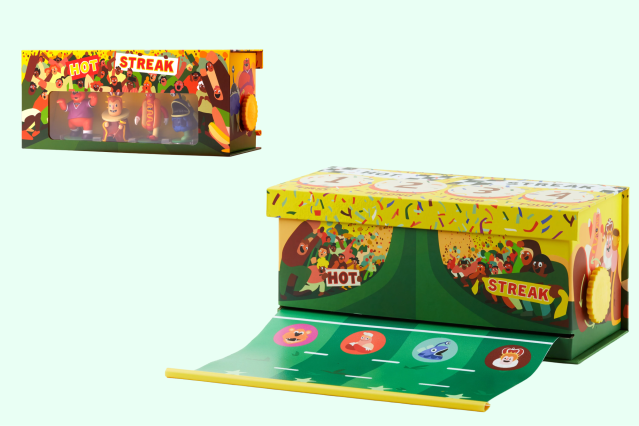
Hot Streak
One of the silliest and most downright hilarious board games of the year is Hot Streak. This highly addictive concept involves players betting on four racing mascots: a bear named Gobbler, a hot dog named Hurley, a fish named Dangle, and a queen named Mum.
Hot Streak is fun for the whole family, as it’s recommended for anywhere between two or more players, aged 6 and up. The rules are also rather simple to understand, so you’ll be playing in no time at all — and it’s highly entertaining despite the basic ruleset.
Based on a random card draw, the mascots run along a racetrack toward the finish line. But there’s a catch that adds a bit of random chaos to each race: You never know which cards will be drawn or the order in which they’ll appear. While certain cards instruct a mascot to move forward, others cause them to move left, right, backward, or to turn around. This results in mascots bumping into each other and sometimes running off the track, resulting in an immediate disqualification.
Each game features three races, taking around 20 minutes total to complete. Before each run, players bet on which mascots they think will win. Once the race begins, there’s nothing more to do but hoot and holler in support of your chosen candidate. After three races, players tally up their money, and the person with the most cash is the winner.

Azul Duel
Azul Duel is the most recent entry in the Azul board game series. While the original and most famous version of Azul can accommodate up to four players, Azul Duel is for more intimate game nights where you’re playing one-on-one.
Players are tasked with compiling colorful tiles based on a type of Portuguese tilework known as azulejo. Participants then use those tiles to decorate a palace roof while taking into account how the patterns they create will look in both the daytime and nighttime.
The game is played over five rounds, each beginning with an acquisition phase in which players select randomly drawn tiles. While you may have an initial plan, part of the fun is pivoting when your opponent picks up the tiles you originally had your eye on.
At the completion of that phase, you place the tiles onto your player board, trying to replicate specific patterns that earn you victory points. After completing the fifth round, bonuses are paid out and scores added up, with whoever has more points being named the victor. With each play lasting only 30 to 45 minutes, this is the perfect game to unbox if you’re looking for a fun, quick activity on an otherwise quiet night.
More Interesting Reads
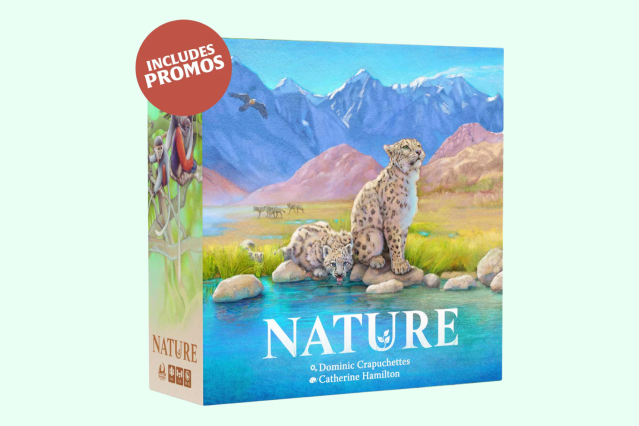
Nature
Nature is the latest installment from the design team behind the award-winning Evolution series. The premise of the game is straightforward: Each player is tasked with growing the population of their assigned species amid a scarce food supply and ever-changing ecosystem. You can also purchase complementary modules that make the ecosystem more fascinating, adding elements such as birds, dinosaurs, natural disasters, and so on.
Nature is intended for between one and four players aged 10 and up, with an estimated playtime of 45 minutes. Games are played over four rounds, with the winner having the highest population total at the end of the game. Certain cards expand the population, increase body size, and help you stock up on food for the feeding phase, where the goal is to keep as much as the population alive and fed as possible.
What makes Nature such a beautiful game is the freedom to make it as complex as you choose. The base game is fun to play on its own, but those in search of a challenge can add as many modules as they like. In fact, thanks to a 2025 Kickstarter campaign, there will soon be more than 700 unique combinations to select from.
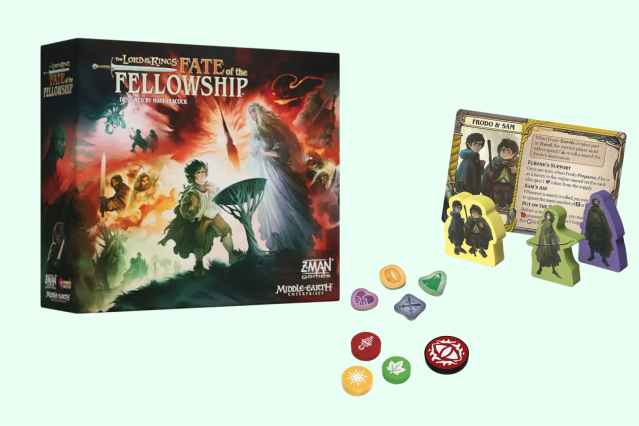
The Lord of the Rings: Fate of the Fellowship
The Lord of the Rings (LOTR) is a cultural juggernaut responsible for some of the best work in not only literature but also film and now board games. Look no further than 2025’s Fate of the Fellowship, which has received rave reviews across the board (please forgive the pun).
The game is designed by board game industry legend Matt Leacock, who also designed the classic game Pandemic. In fact, given the similar game mechanics, some have observed that Fate of the Fellowship is as if Pandemic took place in Middle-earth.
Be forewarned this game isn’t a quick play, but it is a rewarding one. Similar to Pandemic, you’ll be working with instead of competing against your fellow players in this cooperative game, with up to five players controlling two characters each in hopes of achieving a common goal. Each playthrough features a random mix of main goals and sidequests, adding to the game’s variation and replayability.
If you’ve ever read or seen the LOTR trilogy, you’ll note the premise of this game follows the plot. To claim victory, the team must protect Frodo, evade enemies such as the Nazgul, and deliver the One Ring to the fires of Mount Doom. But be careful, because if Frodo’s “hope tracker” hits zero, you lose.
This game is a must-buy for any LOTR fan, as it truly captures J.R.R. Tolkien’s original vision in game form. But you don’t have to be a superfan to play; the game’s mechanics are also well-crafted and would appeal to any board game enthusiast.
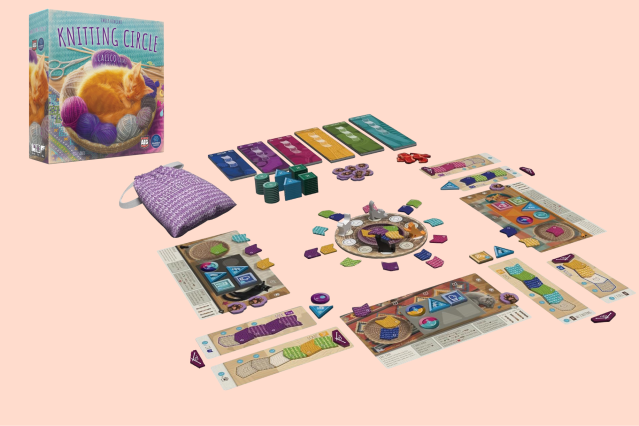
Knitting Circle
Not everyone knows how to knit, but everyone can play the new game Knitting Circle. In this delightful title from Flatout Games, players knit garments to achieve victory points. Along the way, each player has a feline friend that helps them acquire yarn.
The game is beautifully designed by illustrator Beth Sobel, resulting in a cozy aesthetic that captures the calm and pleasant nature of knitting. Knitting Circle is intended for between one and four players aged 10 and up, with each game lasting an average of 30 to 45 minutes.
Part of what makes this game so appealing is its charming narrative, providing a lighter contrast to more intense board games. But that doesn’t mean the game is a cakewalk — it still requires strategic planning to gather yard tiles and knit the most desirable patterns. Be careful to adhere to the approved patterns, or you risk getting an “ugly sweater” pin that causes you to lose points when scores are eventually tallied.
There’s also a puzzle element to this game, as you’ll sometimes be forced to pivot from your original design if certain yarn tiles are snatched up by other players. While it can be frustrating to lose out on the perfect color, you’ll feel a sense of completion the moment you finally complete that mitten you’ve been working on all game. Try Knitting Circle for a calm, thematically pleasant experience the whole group can get behind.
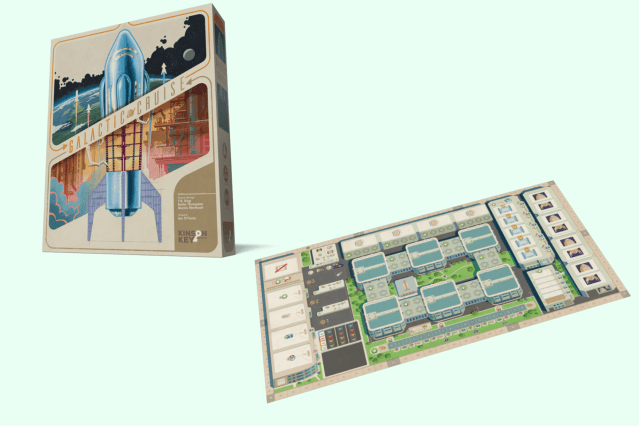
Galactic Cruise
Galactic Cruise is ideal for more avid gamers seeking a real challenge on game night. Up to four players aged 14+ can play this title, which generally takes between 1.5 and 2.5 hours. But be aware that Board Game Geek classifies it as having a high complexity rating at 3.95/5, so it may take a playthrough or two to familiarize yourself with the rules.
Thankfully, each box has an introductory note that gives you instructions on how to organize the game, and a very detailed rulebook as well as clear and concise player aids to guide participants. And the game is just plain fun once you figure it out.
The premise of Galactic Cruise is building and launching spacebound cruise ships as a form of luxury tourism. Each participant plays as a supervisor competing against their fellow supervisors to become the company’s new CEO.
On each turn, players can opt to research new technologies, hire more employees, or take similar actions with the goal of helping the business achieve success. At the end of the game, the supervisor with the most victory points becomes CEO and is declared the winner. In addition to its fun and challenging premise, Galactic Cruise should be lauded for its high quality and attention to detail. While the board may appear overwhelming at first, the layout is quite intuitive in practice.












